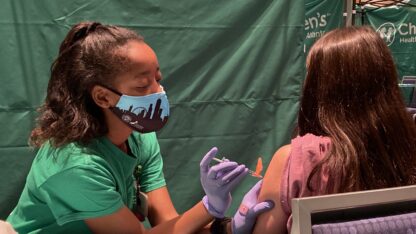State health officials said Friday that the teen has the only known case of the variant so far in Georgia.
Gov. Brian Kemp, at a Capitol press conference, said he had expected that Georgia had the strain because it was already known to be in a few other states, such as Colorado.
“If it’s in the middle of the country, you’ve got to figure it’s in just about every state, or will be soon,’’ Kemp said.
A Kemp spokeswoman later added that “to err on the side of caution, we are operating as if there are more cases of the variant in Georgia.”
Separately, Georgia Public Health officials Friday reported more than 13,000 new COVID cases, a single-day record in the state. The total includes positives from rapid antigen tests.
As bad as the COVID spread now is, both here and nationally, experts believe these new strains are not responsible for the spike in cases seen in many states recently. They believe the upswing is due to people falling ill after holiday travel.
The newer strains are about 50 percent more contagious than the virus that has been most widely circulating in the United States, though it doesn’t seem to be more fatal for any one person who catches it.
While that may seem reassuring, it could be disastrous on a wider scale. One public health expert believes the virus is changing itself to adapt and infect more people.
Another, Adam Kucharski, PhD, an associate professor at the London School of Hygiene and Tropical Medicine who specializes in the math of infectious disease outbreaks, says the math shows the infectious strain will be more deadly overall because of its ability to infect more people.
Kucharski recently compared how many people would die after 10,000 new infections over the course of a month.
With the current situation, with a virus that sees each patient infect an average of 1.1 others and kills .08% of everyone it infects, you’d predict 129 deaths over a month of spread. With a virus that’s 50% more deadly, you would expect to see about 193 deaths over a month of spread. With a virus that’s 50% more contagious, you end up with 978 more deaths over a month of spread — or five times as many deaths.
This means that unless the U.S. adjusts its response to the pandemic, and adjusts quickly, hospitalizations and deaths could reach terrifying peaks in this country over the next few weeks as the variant strains cause a new wave of infections here.
Many more may die
Ashish Jha, MD, dean of the Brown School of Public Health, projected Tuesday that as the new strains take hold in the U.S., they could cause an additional 10 million new infections by the end of February and as many as 150,000 more deaths.
“Without aggressive action to limit the spread of the virus, bolster health care systems around the country, and accelerate vaccine administration, Los Angeles offers a preview of what many communities are likely to experience over the coming months,” he said in a news release.
Hospitals in Los Angeles are severely constrained. On Monday, Los Angeles EMS crews were told to conserve oxygen, because of a shortage of portable oxygen tanks, and not to transport some patients to crowded hospitals if those people’s pulses could not be restored.
Many Georgia hospitals have reported ICU beds being filled. Statewide, more than 30 percent of patients who are hospitalized have COVID. Current hospitalizations for the virus have continually set records and now stand at more than 5,500, and new infections cases reported daily here have approached or topped 10,000 several times recently, including Friday’s record total.
Shift in focus urged
Former FDA Commissioner Scott Gottlieb, MD, predicted Sunday on the CBS show “Face the Nation” that the new strain would be responsible for the majority of new infections in this country by March.
“It’s a big deal for a world that’s already stretched trying to keep in control the old variant,” said Marc Lipsitch, PhD, a professor of epidemiology at Harvard’s T.H. Chan School of Public Health in a call with reporters on Tuesday.
“If we don’t change our control measures, once it becomes common, it will accelerate transmission considerably,” he said.
Lipsitch believes contact tracing efforts in the U.S. — which have been overwhelmed in many places by community spread of the virus — should pivot to focus just on breaking the chains of transmission caused by the new variants.
George Williams was the first Grady Memorial Hospital frontline worker to get the vaccine.
News of the variants has come as the administration of new vaccines has lagged in the U.S., further raising the worry that these strains will get a foothold before people can be protected against them.
In Georgia, Gov. Kemp acknowledged Friday that the distribution of vaccine has been slow in the state. “This has been, and will continue to be, a heavy logistical lift,’’ he said. (Georgia has among the worst vaccination rates in the U.S., according to CDC data.)
Starting Monday, vaccine can be administered in Georgia to people 65 and older, along with first responders, law enforcement officers and firefighters, as supply is available, Kemp added. But already, local health departments have been swamped with calls and email inquiries.
Kemp this week signed an executive order ensuring that EMTs and cardiac techs can administer COVID vaccines, along with nurses. That will help increase vaccinations, he added.
“We still just have a limited supply that we’re getting from the federal government,’’ Kemp said, calling for Georgians’ patience.
Lockdown in Britain
Already, one new “super strain” of the virus is driving an alarming surge of COVID cases in Britain. On Monday, Prime Minister Boris Johnson — who had resisted tougher control measures for weeks — reluctantly ordered strict new lockdown measures in England, following close behind similar moves in Scotland, Wales and Northern Ireland.
Defending his actions in light of the economic harm they would cause, he said he had no choice but to lock down again as new cases threatened to overwhelm hospitals.
Once again, most children will stay home for school, and people have been asked not to leave home except to do a very limited number of essential tasks, like seeking health care or going grocery shopping.
A new report from Imperial College London found that a greater proportion of children were infected with the new strain, compared to the older version of the virus. It’s not clear yet if its mutations make it better at infecting children, or if younger people were just more likely to be exposed to it because kids have continued to go to school there, even as many adults have stayed home.
One of the new super strains — the so-called UK variant — has been detected in five other U.S. states besides Georgia, the CDC said earlier this week: Colorado, California, New York, Florida, and Pennsylvania.
Texas and Connecticut public health officials announced Thursday that they had identified their first cases of the more contagious variant of the coronavirus, known as B.1.1.7.
Greg Armstrong, MD, director of advanced molecular detection at the CDC’s National Center for Emerging and Zoonotic Infectious Diseases, said he thinks fewer than one in 200 COVID-19 cases in the U.S. are currently caused by mutated UK strain, but there’s some uncertainty around that number because the U.S. has done a limited number of gene tests on samples of the SARS-CoV2 virus.
His estimates are based on results from commercial testing companies Illumina and Helix, which have partnered with the CDC to look for the variant as they process COVID tests. Helix screened more than 2 million COVID tests for signs of the variant. They forwarded 158 samples to Illumina for further testing. Of those, 51 were positive for the UK variant. According to the companies, as of Jan. 6, 54 cases of the UK variant had been identified in the U.S.
Going forward, the plan is for Illumina to sequence the genomes of 1,000 samples per week to look for the UK variant and others.
Many people infected with the new variant have no history of travel, which suggests it is already being passed person-to-person in some areas.
Still, experts believe this variant is not the main reason for the surges of cases in the U.S. The South African variant has not yet been detected in the U.S., though it has been in the UK.
Commercial labs doing PCR testing for the virus are looking for cases where one of the three probes — or markers — they use to detect proteins in the spike of the virus is negative while the other two probes are positive.
These “s-gene dropouts” can happen with many versions of the virus that are circulating, not just the super strains. Labs then have to follow up with a test that reads all the genes in the virus to look for the signature mutations in the super strains.
The University of Washington is actively doing this genome sequencing to look for the UK strain, but it hasn’t found any cases out of 250 positive cases it screened last week, says Alex Greninger, MD, PhD, assistant director of the clinical virology laboratories at the University of Washington Medical Center.
How mutations work
Viruses mutate all the time. Mutations are errors a virus makes when it copies itself. Coronaviruses mutate more slowly than most others because they have a built-in proofreading mechanism that corrects these errors.
But they can still change in ways that the proofreader doesn’t catch or fix.
Most of the time, these changes don’t make them more harmful. But sometimes a mutation makes for a competitive advantage, something that allows that version to outperform the viruses around it.
Because the new coronavirus has infected so many millions of people around the world, it has had more opportunity to mutate, and it is adapting to become better at infecting people.
Both the UK super strain and the super strain found in South Africa have the same mutation on their spike protein — called N501Y. But each strain developed the mutation independently. When you see things like that, Greninger says, it probably didn’t happen by chance. The virus is evolving in ways that make it better at infecting humans.
“To me, the dominant story of the UK variant right now, as it stands, is adaptation to humans,” he says.
The mutations on the viruses’ spike protein work together to make the virus more infectious, according to recent research by Rafael Najmanovich, PhD, a professor of systems and structural biology at the University of Montreal.
The spike proteins on the virus rotate between “open” and “closed” positions. They can attach to doors on our cells called ACE2 receptors only when they are in their open positions.
Najmanovich’s modeling shows new gene changes allow the spike proteins to stay open about 40% longer than the older versions of the virus, which means that each individual particle of virus is more likely to be able to infect our cells when we come into contact with it.
In theory, that means fewer copies of the virus — a smaller dose — is needed to make a person sick, though Najmanovich says this still needs to be proved in an experiment. His research has been published in a preprint article that has not yet been peer-reviewed.
Better masks needed?
Because the virus is becoming more potent in its ability to spread, we will need stricter measures to control its spread, experts say.
In recent days, some public health experts, like former CDC Director Tom Frieden, MD, who now leads the nonprofit Resolve to Save Lives, said it might be a good idea for people to wear more protective masks — like surgical masks or N95 respirators, though these still may be in short supply across the country.
Lipsitch, at Harvard, said given the more contagious nature of the new variants, it’s more important than ever to stay home as much as possible, limit contact with those outside your household, and, he said, cut daily contacts by at least a third to slow the pace of new infections and once again flatten the curve.
It’s still not known whether the mutations will affect how well the approved vaccines work, but experts believe that because vaccines generate a big immune response in the body that acts against the virus in different ways, the new shots will probably still work. However, pharmaceutical companies are running tests now to make sure.
Still, the vaccines won’t help if they aren’t made more widely available, more quickly.
Ultimately, the new strains could send kids back to virtual learning, just as schools in many areas were getting ready to reopen.
“If we’re not going to close other kinds of activities, we shouldn’t close schools, because schools are more important than almost anything else that we do in terms of what they produce and what they allow the rest of society to do,” Lipsitch said, but the virus many not give us a choice.
“The UK has decided to close schools, and I think we might find ourselves there in not too long,” he said.










